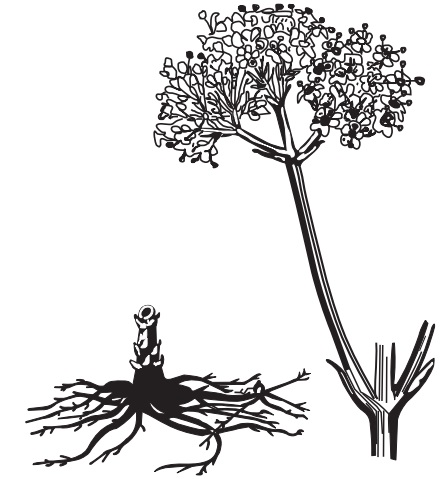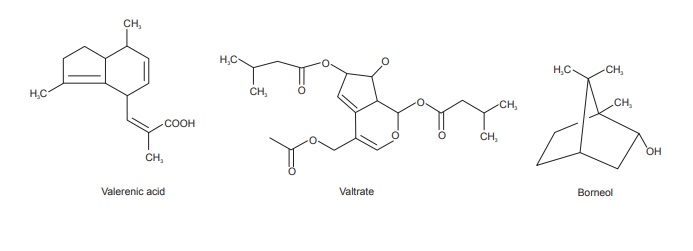Valerian
| Home | | Pharmacognosy |Chapter: Pharmacognosy and Phytochemistry : Drugs Containing Volatile Oils
Valerian consists of the dried roots and rhizomes of Valeriana wallichi Linn., belonging to family Valerianaceae.
VALERIAN
Synonyms
European valerian, English valerian, German valerian,
Val-eriana rhizome.
Biological Source
Valerian consists of the dried roots and rhizomes of Valeriana wallichi Linn., belonging to family Valerianaceae.
Geographical Source
It is indigenous to Britain and also found in Holland,
France, Japan, Belgium, and Germany.
Cultivation and Collection
Valerian does well in all ordinary soils, but prefers rich,
heavy loam, well-supplied with moisture. Preference is given in collecting root
offsets. The daughter plants and young flowering plants, which develop towards
the end of summer, at the end of slender runners given off by the perennial
rhizomes of old plants. They are set 1 foot apart in rows, 2 or 3 feet apart in
soil pretreated with farmyard manure, and after planting it is supplied with
liquid manure timely along with plenty of water. Weeding requires con-siderable
attention.
Seed propagation is also done. The seeds are either sown
when ripe in cold frames or in open in March in gentle heat. Transplantation if
required is done in May to perma-nent quarters. But to ensure the best alkaloidal
percentage, it is best to transplant and cultivate the daughter plants of the
wild Valerian. The flowering tops are cut off so as to enabling the better
growth of the rhizome. Many of the young plants do not flower in the first
year, but produce a luxuriant crop of leaves and yield rhizome of good quality
in the autumn. In late September or in early October, all the tops are cut off,
and the rhizomes are harvested. Large rhizomes are cut into transverse or
longitudinal slices and dried as quickly as possible at low temperature.
Characteristics
The drug are found either entire or sliced erect rhizome,
which is dark yellowish-brown externally. It has a size of about 1 inch long
and 1/2 inch thick, having numerous slender brittle roots from 2 1/2 to 4 inches
long and few short, slender, lateral branches are also present. The rootstocks
are sometimes crowned with the remains of flowering stems and leafscales are
usually firm, horny, and whitish or yellowish internally. A transverse section
shows irregular outline and exhibits a comparatively narrow bark, separated by
a dark line from an irregular circle of wood bundles of varying size.

Chemical Constituents
The chief constituent of Valerian is a yellowish-green to
brownish-yellow oil, present in the dried root to the extent of 0.5 to 2%. Oil
is contained in the sub-epidermal layer of cells consist of valerianic, formic,
and acetic acids; the alcohol known as borneol and pinene. Fresh rhizomes are
reported to have glucoside, alkaloid, and resin.

Uses
Valerian is used in the treatment of insomnia, hysteria,
blood pressure, as an anticonvulsant in the treatment of epilepsy. Valerian can
produce a mild and safer sedative without producing any addiction and
dependency. Valerian has shown to have some antitumor activity, also used as
aromatic, stimulant, nervine, emmenagogue, anodyne, and antispasmodic. It can
promote menstruation when taken hot. Useful in colic, low fevers, to break up
colds and relieves palpitation of the heart. Oil of Valerian is employed as a
popular remedy for cholera, in the form of cholera drops and also to a certain
extent in soap perfumery.
Marketed Products
It is one of the ingredients of the preparations known as
Mentat, Anxocare (Himalaya Drug Company) and Saptagun taila (Baidyanath).
